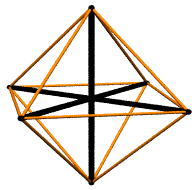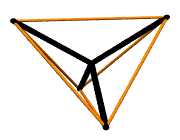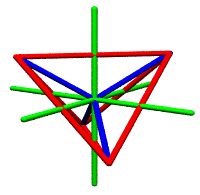| In sum, the xyz game needs two operations:
vector grow/shrink and vector reversal, in support of tip-to-tail
vector addition, in order to reach all points, whereas the quadray
game only needs the grow/shrink operation, and not vector reversal,
to have vector addition perform adequately.
Because we habitually associate number or magnitude with length
or distance in any number of contexts, including that of the "real
number line", it is perhaps somewhat more problematic to separate
our concepts of "scalar" and "vector" than the linear algebra text
books would have us believe.
Adapting the quadrays notation to the number line, we might use
coordinate pairs in place of signage, i.e. write (0,3) in place of
-3, and (3,0) in place of +3. Then we might then write
|(0,3)| = |(3,0)| = 3, meaning the absolute value of these
two entities is the same, but is not geometrically equivalent to
either one.
|
| But then isn't absolute value generally considered
a length or distance? Absolutely. Therefore its representation
takes us back to the number line, where it becomes congruent with
+3 -- or (3,0) -- but never with -3, or (0,3). But why is one side
of zero favored as the location for "absolutes", while the other
side is not?
(0,3) and (3,0) look a lot more like vectors, notationally
speaking, than do -3 and +3, especially in light of the fact that
we don't usually write +3, but 3 -- the same symbol we use for the
value of |-3|. In ordinary notation, it looks like 3
is its own absolute value, but that -3 isn't "absolute" in the same
way. This asymmetry carries over into the language of linear
algebra, wherein only the positive xyz vectors (1,0,0) (0,1,0)
(0,0,1) are the "basis" vectors, even though mirror images of these
vectors do the same work.
Quadrays provide an opportunity to study all these design issues
regarding the geometric interpretation of our symbolic processes
(and vice versa). They provide useful contrast with xyz in the
sense that they don't require these two different "kinds" of scalar
multiplication (the length-changing kind and the
orientation-changing kind) and thereby give us a sense of what it's
like to not have "negative mirroring" operative in quite the same
way.
The interface between numbers and geometry is only simple and
straightforward at first glance. Once you start to investigate this
interface more deeply, many issues arise for consideration -- as do
the recorded thoughts of many thinkers who have wrestled with these
very questions. Linear algebra as a discipline is one of the more
historically recent attempts to formalize and codify this
interface.
If we agree that the quadrays apparatus consists of four "basis
vectors" which span volume when abetted with strict scaling and
vector addition, then we come up against the concept of
"dimension", which in linear algebra is always identified with the
number of basis vectors necessary to span a vector space.
Shall we say that "volume is 4D" then?
Given this is the same volume mapped by xyz, the one we all
learn fairly early on is "3D", such an alternative nomenclature is
unlikely to stand much chance of widespread adoption. However, this
usage of "4D" is consistent with the writings of at least one
mathematically-inclined philosopher, namely those of R. Buckminster
Fuller, author of Synergetics: Explorations in the Geometry of
Thinking. So at least one (albiet highly specialized)
application of the quadrays "language game" has so far emerged
within our shared curriculum context. Perhaps others will
follow.
For further reading:
Synergetics
on the Web
maintained by Kirby
Urner
|



